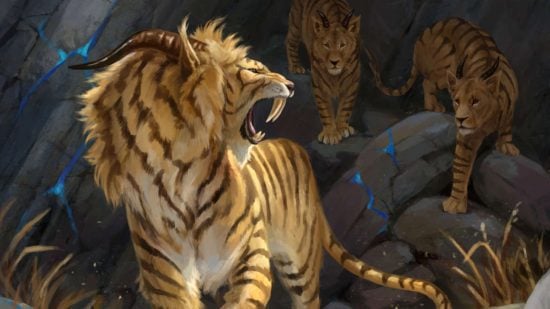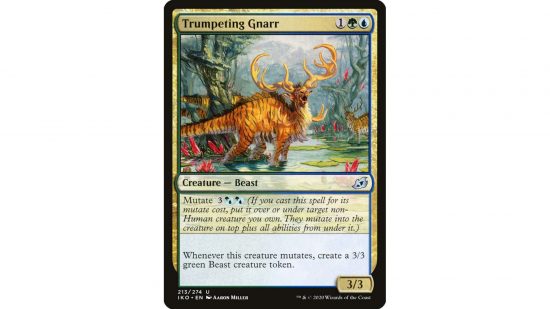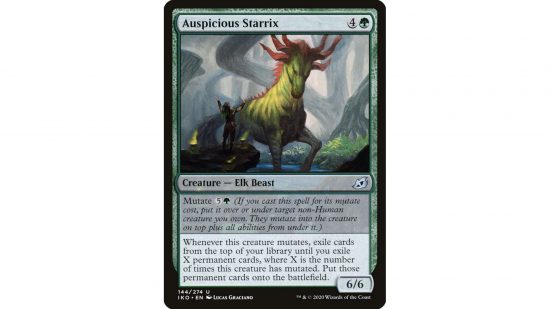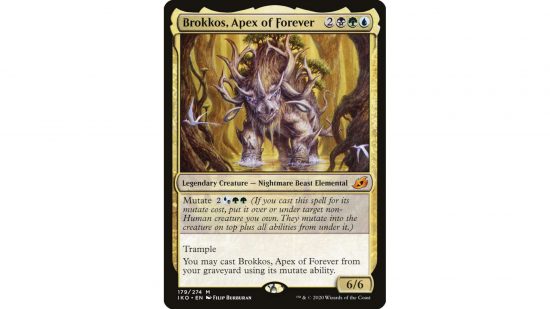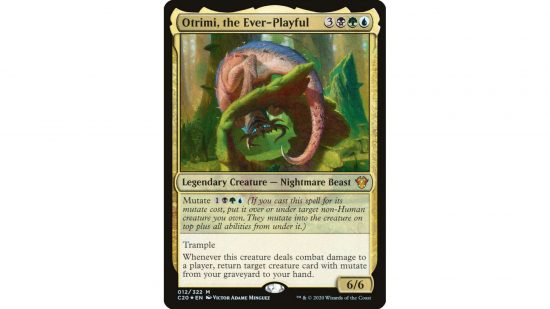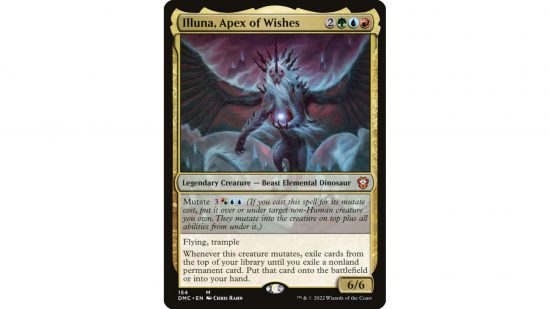MtG mutate cards seem simple at first, but the mutate keyword is one of the least intuitive in all of Magic the Gathering. Mutate turns two or more creature cards into one permanent, merging their abilities, and usually granting a special benefit when you do so – but the specific wording of the rules generates many edge cases you need to be aware of.
Magic the Gathering cards with mutate appear almost exclusively in the Ikoria MtG set and MtG Commander decks – you can check out our guide to MtG Arena codes if you’d like to pick up some Ikoria cards and experiment with mutate in Historic or Brawl.
You can cast a creature with the mutate keyword for an alternate mutate cost, provided you already control a creature. If the spell resolves you’ll merge the two creatures, putting one card on top of the other. You’ll use the top card’s stats and name going forward, while gaining the text abilities of the creature underneath. Seems simple? It’s not.
Here’s what you need to understand when playing with and against MtG cards with the mutate keyword:
Mutating creatures don’t enter the battlefield
If you cast a creature for its mutate cost and it successfully mutates, it isn’t considered to have entered the battlefield. It (and the creature it merges with) are considered to have mutated. Many MtG mutate cards have abilities that trigger when they (or another card) mutates.
You can mutate the same creature multiple times
You can keep mutating new creature spells onto an existing merged creature, creating a taller and taller stack of abilities. Many mutate creatures take advantage of this, with abilities that trigger “each time this creature mutates”, and you can collect a pile of different mutate triggers in one body.
Removal interacts with mutate spells strangely
If your opponent casts a creature for its mutate cost and you remove the creature it was mutating onto, the mutating creature spell doesn’t fizzle. Instead, the creature enters the battlefield as if it had been cast normally.
Self-referential card abilities still work for merged creatures
Many creatures have ability text that reference the card by name; for example, “When Orcish Bowmasters enters the battlefield…”. When these abilities appear on the card text of a merged creature, they’re considered to simply reference “this creature” instead.
You can’t mutate for free
Effects like Cascade or spells like Omniscience allow you to cast spells for free. Strictly speaking, they let you cast the spell for an alternate cost of zero mana. Picking this alternate cost means not choosing to cast the spell for its mutate cost; as such you can’t mutate the creature to merge it with another one already on the battlefield.
A merged creature is one permanent made of multiple spell cards
When a merged creature changes zones, all the cards that make it up move together. If it’s bounced to hand by an Unsummon, all the cards go back to your hand. But it’s still only one creature, so if it’s destroyed, there’s one trigger for a creature dying, even though multiple creature cards will enter the graveyard from the battlefield.
Things get weird if a spell or effect exiles the merged creature and then returns it to the battlefield, such as with a blink spell. As soon as the merged creature enters exile it turns back into a stack of cards: each of those creature cards then enter the battlefield separately.
You can mutate onto your commander
Otrimi, the Ever-Playful is a dedicated mutate commander which has the mutate keyword. You can also merge any other creature Commander with any other mutate creature. No matter which card you put on top, the merged Creature remains your commander.
If a card specifically states that it moves Commanders from the battlefield to the Command Zone, anything that’s been mutated onto your Commander moves along with it, then falls off – and will probably be stuck there, since there’s no way to cast non-commander creatures from the Command Zone.
This video by YouTuber FishMTG explains even more weird interactions for Mutate in Commander.

You can mutate anything that’s a creature, and it gets weird
Many non-creature permanents have abilities to temporarily turn into creatures. Planeswalkers like Sarkan the Masterless and various Gideons have loyalty abilities that let them temporarily turn into creatures, as do creature lands like Crawling Barrens or Mutavault.
Some multi-type permanents are only creatures while certain conditions are met, like the enchantment gods of Theros that are only creatures when your devotion to their color is high enough. As long as these permanents are creatures they’re eligible to merge with a mutating creature spell.
What happens when the effect that made the permanent into a creature ends? In part, that depends on which card you put on top. If you mutate a creature on top of Sarkan the Masterless, you’ll have a creature permanent. However it will still have his loyalty abilities, including the ability to turn into a 4/4 dragon.
Since the permanent is a creature and not a planeswalker, it can’t be chosen as a target when your opponent declares attackers, and it won’t leave the battlefield if it runs out of loyalty counters.
The card text on all cards in the merged permanent may also determine its type. If you mutate onto Klothys, God of Destiny, the card text “As long as your devotion to red and green is less than seven, Klothys isn’t a creature” will always be in effect, whether Klothys is the topmost card or not.
